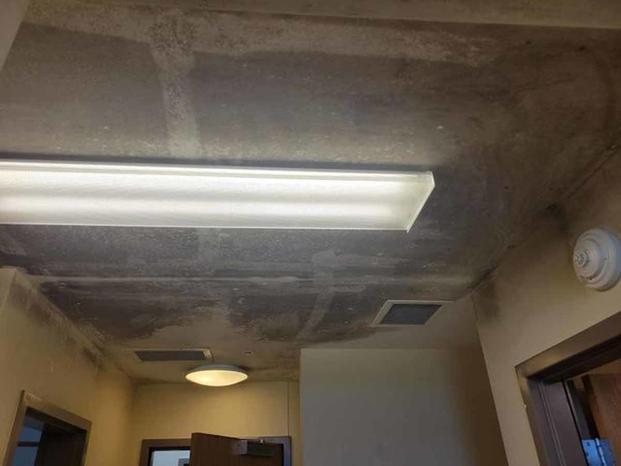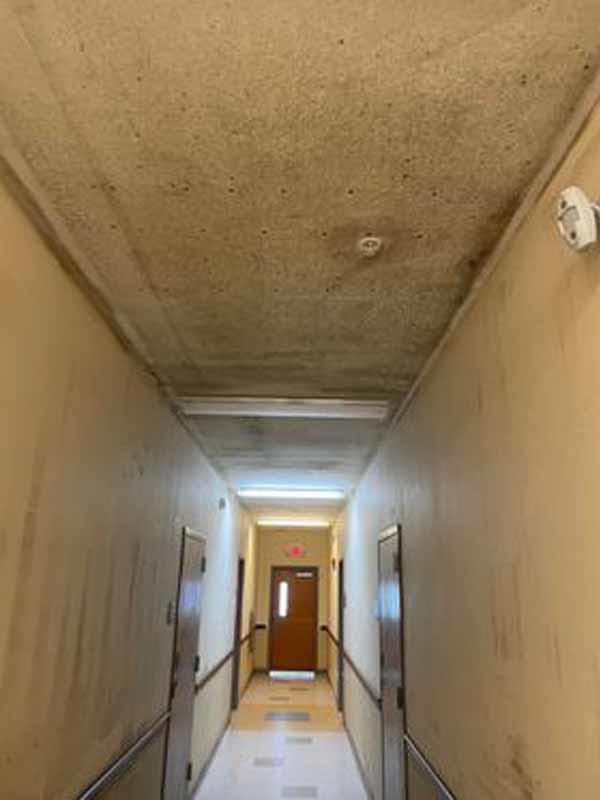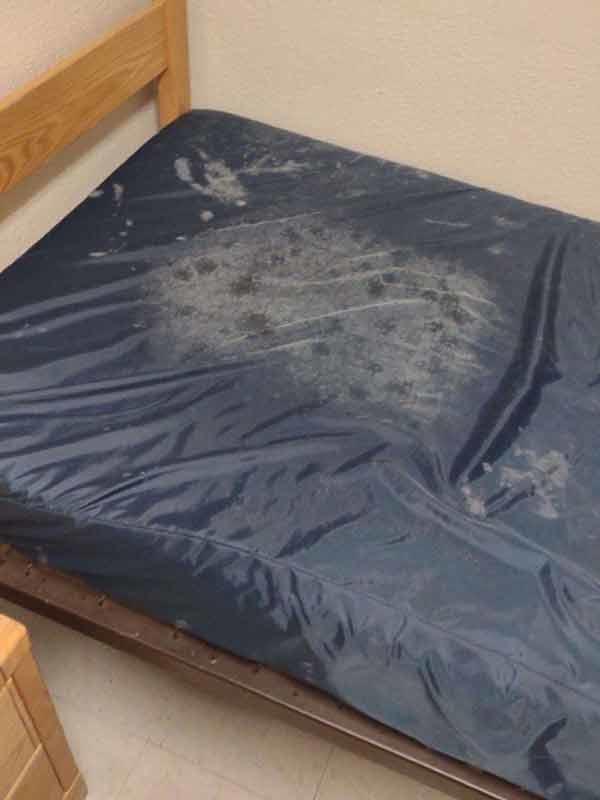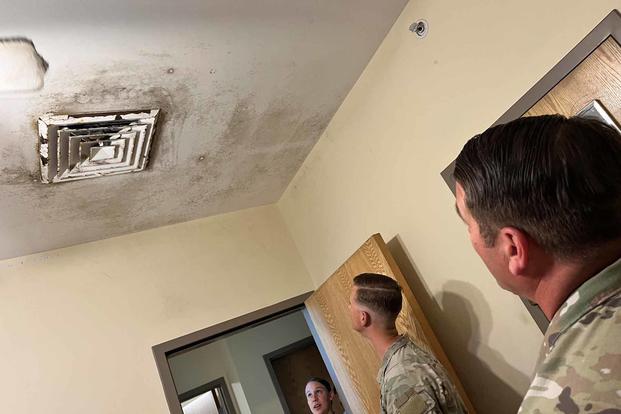After a long mission in Europe, a soldier returned to his Fort Stewart barracks only to discover mold had completely consumed his room. The infestation wasn't only on the walls; his bags and bed turned black and green, encrusted in mold. Most of his belongings were ruined.
Broken air conditioners in the sweltering, humid Georgia heat; poor ventilation; and little to no barracks maintenance have created a decades-long breeding ground for mold, which soldiers repeatedly try to clean to no avail.
"This is the reason a lot of us are getting out," the soldier who found his room blanketed in mold and who is leaving the Army in a few months told Military.com. "We can't live like this. … It's up to junior soldiers to get this stuff out to [the press] or on social media, and that's the only way senior leaders are going to know they failed."

Read Next: Lawmakers Want to Increase Military Training for Taiwan as Tensions with China Intensify
The barracks' halls and doors will suddenly appear painted black with mold. In soldiers' rooms, the mold spreads quickly onto mattresses and gear if they must leave for extended periods of time and don't constantly combat the crud.
Military.com spoke with more than 20 soldiers, mostly junior enlisted troops but also commanders and senior noncommissioned officers.
All of them spoke on the condition of anonymity, because they were not authorized to speak to the press. In every interview, troops described disgusting conditions that would get an apartment or restaurant in the civilian world condemned.
They painted a picture of senior leaders blasting platoon-level NCOs for not being harder on their soldiers to clean; young soldiers being told to buy their own cleaning and protective supplies to scrub mold, stretching their already thin paychecks; and the service's arm in charge of maintaining facilities on post almost never responding to problematic living conditions.

Officials at Fort Stewart have no plans to relocate soldiers living in moldy barracks -- an issue that has plagued the Army as a whole for years -- and units will have to wait more than a decade for new dorms that are less likely to become a breeding ground for mold to be built, long after all soldiers currently stationed at the base have retired or moved.
Exposure to mold leads to a wide range of health issues, according to the Centers for Disease Control and Prevention, including stuffy noses, headaches, fatigue, wheezing, itching, and fungal and respiratory infections in more extreme cases. A World Health Organization study in 2009 found a link between mold exposure and memory loss, lethargy and the development of asthma in children. Mold can also make someone susceptible to more severe allergic reactions related to other allergies.
Army officials declined to make any senior service leaders available to discuss the mold issues reported by soldiers at Fort Stewart. The issues at the base come after press coverage of mold issues, first detailed by Military.com, at Fort Bragg, North Carolina, where Army press officials struggled to answer basic questions about what the service would do to address the problem.
A week after Military.com contacted Army press officials with details of accounts from soldiers about the pervasive mold problem, Fort Stewart held a so-called "stand down day" to teach NCOs how to tackle mold issues and issued a press release after being told Military.com planned to publish this story. That statement had few details on how the garrison is combating mold. Even soldiers on leave were encouraged to attend mold remediation training virtually, and leaders opened every barracks room for a sudden inspection, according to multiple text messages reviewed by Military.com. Commanders at Schofield Barracks, Hawaii, also had widespread barracks inspections this week after Military.com interviewed soldiers stationed there about moldy conditions.
'Operation Eradicate Mold'
After Military.com began asking questions, garrison leaders at Fort Stewart launched "Operation Eradicate Mold," which tasks soldiers to clean mold every other day from 11 a.m. to noon, according to an internal memo and text messages reviewed by Military.com. Platoon-level NCOs are then expected to inspect all rooms. Sergeant Major of the Army Michael Grinston and Army Secretary Christine Wormuth inspected barracks at Fort Benning, Georgia, on Tuesday.
"We can clean all day, but this [mold] is going to grow back," one staff sergeant at Fort Stewart told Military.com. "This isn't because my guys left a pizza box out too long. This is an actual infrastructure issue."
Mold issues are nothing new to the service and frequently draw scrutiny from Congress and lengthy complaints from junior troops online, but it is rare that garrison leaders publicly advocate for additional resources or otherwise acknowledge problems.

"Soldiers often need to file complaints with Congress, the Army secretary or the press," said Katherine Kuzminski, director of the military, veterans and society program at the Center for a New American Security, a Washington, D.C.-based think tank.
"The cultural part of the military is hardship breeds character," she added, noting that complaints from junior enlisted soldiers are rarely taken seriously, and that troops often fall under leaders who lived in similarly bad conditions and have either forgotten about the experience, or believe others should live in the same conditions they did.
Behind many of the mold issues that are springing up across the service are the old barracks known as VOLAR buildings, constructed under the Army's Project Volunteer Army program in the 1970s. That effort aimed to construct barracks with high-quality living quarters, giving soldiers amenities like kitchen appliances and more privacy. They were a major upgrade from World War II-style barracks in which entire platoons would share an open room, a design the Army relied on during most of the 20th century.
"Base location decisions were largely made when large swathes of land were for an affordable price," Kuzminski said. "But these locations are more susceptible to increasing temperatures. The more modern barracks are approaching the age [where] they need regular upkeep. It's gotten to the point where it's beyond updating the HVAC system."
But that move for better barracks after the service transitioned to an all-volunteer force would go on to haunt the Army. Many service leaders believe the barracks' shoddy construction and aging air conditioning units are the underlying cause of the mold issues.
In August, Fort Bragg started evacuating some 1,200 soldiers from similar barracks amid serious mold issues. The 12 Smoke Bomb Hill barracks there that were deemed to be unlivable are set to be demolished next year, with new barracks replacing them five years ahead of schedule.
However, that move was made only after the issue drew the ire of lawmakers, concerns from Wormuth, and media scrutiny. Army bases do not have excess barracks in most cases, so relocating soldiers is a difficult move for garrison leaders. Fort Bragg officials are giving soldiers housing allowances and letting them live in on-post hotels free of charge.
But Fort Stewart leadership is not considering such a move. Fort Bragg's relocation effort is the most dramatic action any base has taken. The move will put strains on the base for most of the rest of the decade, making it unlikely to become a precedent for other garrisons. Senior leaders there have to find space where they can place troops, which is expected to take months. And simply giving all displaced soldiers a housing allowance would stretch an already limited real estate market in surrounding Fayetteville, North Carolina.
At Fort Stewart, officials say there is no need to relocate any troops.
"The team was able to go into that battle rhythm and get the rooms cleaned. We haven't gotten any requests or identified [a need] for that," Command Sgt. Maj. Quentin Fenderson, the 3rd Infantry Division's top enlisted leader, told Military.com in an interview Thursday about moving soldiers out of the infested barracks.
There are 535 VOLAR barracks in the Army's inventory, 30 of which are at Fort Stewart. However, mold issues are not exclusive to those old living quarters, or even barracks. Military housing across the country had long suffered from poor conditions, including at Fort Belvoir, Virginia ,where at least a dozen families have been displaced due to subpar housing conditions, including mold and rodent and roach infestations, according to reporting from Task & Purpose.
Fenderson said the rooms are being cleaned, yet Military.com has reviewed dozens of photos and videos from soldiers and FaceTimed with other sources at Fort Stewart since early September, showing that the mold persists.
Fenderson partly blamed the humid conditions of Georgia. However, Military.com found little evidence of systemic mold issues in other industries in the South, including housing for college students, hotels and gyms. He also pointed to the standard revolving door of leadership on base, including platoon-level NCOs, who move on and then the next person must be brought up to speed on the mold issue. Perceived blame against lower-level NCOs is something that has drawn the ire of the rank and file at Fort Stewart.
"The problem is we get a change of leadership that comes into the formation," Fenderson said. "We need to make sure all leaders are trained."
But training on mold mitigation and cleaning has been virtually nonexistent. Fort Stewart officials pointed to a civilian certification program for soldiers to learn how to combat mold, but could not answer questions on how many troops have been certified. In interviews, no soldiers, including a commander on the base, had ever heard of such a training program. Mitigation is often rudimentary, such as issuing dehumidifiers, which can only slow down the rate of mold growth. The CDC says humidity levels indoors need to be below 50%. Two soldiers said their dehumidifiers read their rooms at around 70% humidity.
Painted with Mold
Most Fort Stewart soldiers interviewed said that their company-level leadership is often sympathetic. But commanders on that level have relatively little influence over living conditions. In some cases, junior soldiers told Militay.com that their commanders or NCOs would buy gallons of bleach, gloves and other cleaning supplies because getting it from the Directorate of Public Works, or DPW, which oversees facilities, is too difficult -- effectively creating a situation in which soldiers are using their own income to subsidize DPW's work.
One noncommissioned officer detailed the barracks their soldiers live in as looking like it's painted with mold, with the walls and doors almost completely covered.
"When I first moved here originally, I noticed the mold. It [kept] growing, I kept cleaning it, and it kept coming back. It got worse and worse, to the point where it is today," the NCO told Military.com. "All we get told is to put in work orders."

Those work orders go to DPW, which has about a 10-person staff who are in charge of maintaining facilities at Fort Stewart. But the NCO, and all other soldiers interviewed, could not think of a single anecdote in which DPW performed mold mitigation, which sometimes can include removing parts of ceilings and walls. In virtually all cases, soldiers were told their mold issue was not categorized as a priority in DPW's internal system and that they needed to clean it themselves.
"A DPW [worker] came into [the] room with basically a hazmat suit on, respirator … the whole white getup," one junior infantry soldier told Military.com, describing a mold issue being inspected. "They're like, 'Yeah that's pretty bad, you should clean this up,' and left."
Soldiers are often told to clean with bleach they should buy themselves. Yet the Occupational Safety Health Administration, or OSHA, and the Environmental Protection Agency both say bleach shouldn't be used to routinely treat mold. While bleach can scrub away mold, the spores still exist in many cases and will just grow back. In some instances, bleach can make a mold problem worse due to the water in it eventually evaporating after use. Troops interviewed also said they are not given proper protection gear such as gloves, goggles or respirators, as recommended by the Centers for Disease Control and Prevention.
DPW officials at Fort Stewart told Military.com that they have done plenty of mold mitigation and cleanup, which includes the use of hydrogen peroxide. Fort Stewart Director of Public Works, Jamie Heidle, described efforts in several buildings. However, none of those buildings was among the eight barracks from which Military.com reviewed photos or interviewed soldiers who were residents. Officials also refuted claims soldiers aren't properly equipped with all the supplies they need to do their own cleanup.
"Every soldier is provided the equipment they need to clean up," Fenderson said. "Sometimes, you have leaders that don't do the right thing. Some will identify a problem, but because they have [something else] they see as a higher priority, it doesn't [get fixed]."
The Army as a whole allocates roughly $1 billion per year on barracks construction, maintenance and renovation. Fort Stewart's 30 VOLAR barracks are all set for major renovations, costing about $15 million per building. The base has also been approved for the construction of new barracks consisting of 372 rooms, but it's unclear how many buildings that will end up being. All that new construction and renovation won't be completed until at least 2035.
But that might not be enough money to keep maintaining old barracks while building enough new ones. On Tuesday, Wormuth told Stars and Stripes that the Army has underinvested in housing.
"With everything that we were doing in the last 20 years, where the focus was so much downrange, you know, we probably were not paying as close attention to our own infrastructure, as we are right now," she said.
Army officials with direct knowledge of construction efforts blamed federal bureaucracy and tangling with Congress. One Army official said a single barracks takes, on average, at least five years to complete. For comparison, the Pentagon was built in 16 months during World War II.
As for Fort Stewart, Fenderson, who is effectively in charge of soldier welfare for the 3rd Infantry Division, says the base doesn't need more resources and felt satisfied with the decade-long timetable for barracks construction and renovations.
"The Army has a plan in terms of how things are budgeted, and it's working out," he said. "We have a responsibility to make sure soldiers have everything we need, and I think we're getting after it."
-- Steve Beynon can be reached at Steve.Beynon@military.com. Follow him on Twitter @StevenBeynon.
Related: Mold Issues, Poor Housing Conditions for Troops Are Rampant. What Can Congress Do?













